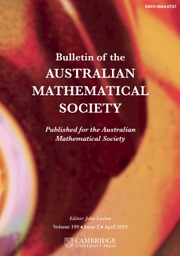No CrossRef data available.
Article contents
A note on analytic capacity
Published online by Cambridge University Press: 17 April 2009
Abstract
Core share and HTML view are not available for this content. However, as you have access to this content, a full PDF is available via the ‘Save PDF’ action button.
Let K be a 2-dimensional Cantor set. In this note we prove, in two cases, the analytic capacity and the continuous analytic capacity of K are equal.
Information
- Type
- Research Article
- Information
- Bulletin of the Australian Mathematical Society , Volume 46 , Issue 3 , December 1992 , pp. 361 - 365
- Copyright
- Copyright © Australian Mathematical Society 1992
References
[1]Davie, A.M., ‘Bounded approximation and Dirichlet sets’, J. Funct. Anal. 6 (1970), 460–467.Google Scholar
[2]Gamelin, T.W., Uniform algebras (Prentice Hall, Englewood Cliffs, New Jersey, 1969).Google Scholar
[3]Gamelin, T.W. and Garnett, J., ‘Constructive techniques in rational approximation’, Trans. Amer. Math. Soc. 143, 187–200.CrossRefGoogle Scholar
[4]Garnett, J., Analytic capacity and measure, Lecture Notes in Math. 297 (Springer-Verlag, Berlin, Heidelberg, New York, 1972).Google Scholar
[5]Garnett, J., ‘Positive length but zero analytic capacity’, Proc. Amer. Math. Soc. 21 (1970), 696–699.CrossRefGoogle Scholar
[6]Marshall, D.E., ‘Removable sets for bounded analytic functions’, in Linear and complex analysis-199 Research Problems, Lecture Notes in Math., 1384, pp. 485–490 (Springer-Verlag, Berlin, Heidelberg, New York, 1984).Google Scholar
[7]Murai, T., A real variable method for the Cauchy transform and analytic capacity, Lecture Notes in Math., 1037 (Springer-Verlag, Berlin, Heidelberg, New York, 1988).Google Scholar
[8]Ohtsuka, M., ‘Capacité d'ensembles de Cantor généralisés’, Nagoya Math. J. 11 (1957), 151–160.CrossRefGoogle Scholar
[9]Vitushkin, A.G., ‘Analytic capacity of sets and problems in approximation theory’, Uspekhi Mat. Nauk 22 (1967), 141–199.Google Scholar

